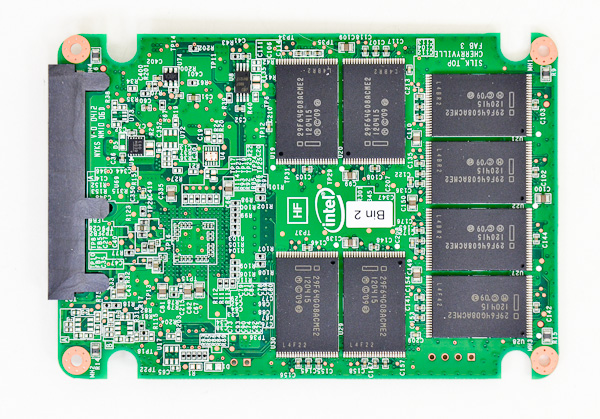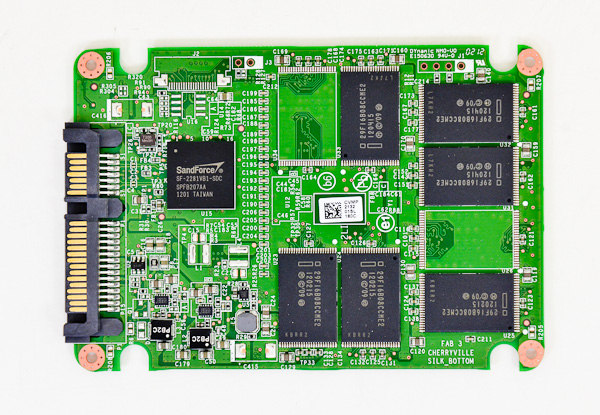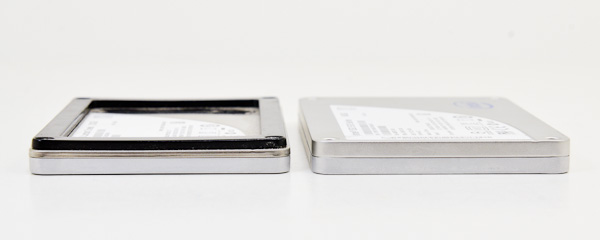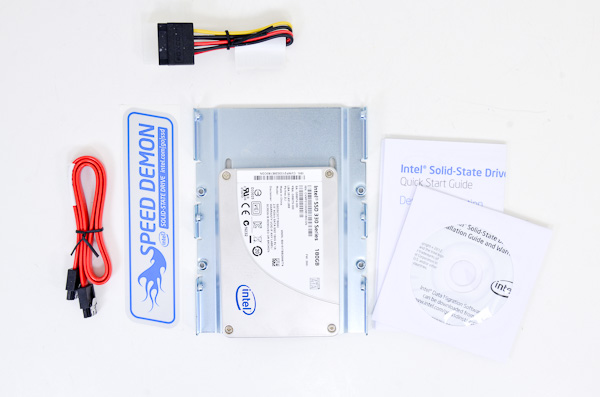The Intel SSD 330 Review (60GB, 120GB, 180GB)
by Anand Lal Shimpi on August 1, 2012 12:01 AM ESTThe Drives and Internal Architecture
The SF-2281 controller features eight NAND channels, although it can pipeline multiple requests on each channel. The 60GB and 120GB drives both feature eight NAND packages with one 8GB die and two 8GB die per package, respectively. That works out to be 64GiB of NAND on the 60GB drive, and 128GiB of NAND on the 120GB drive. RAISE is disabled on both of these drives, all spare area is dedicated for the replacement of bad blocks as well as garbage collection/block recycling.

Intel's SSD 330 60GB, all NAND appears on one side of the PCB
The 180GB drive on the other hand uses twelve NAND packages, with two 8GB 25nm MLC die per package. The math works out to be 192GiB of NAND. SandForce's redundant NAND technology (RAISE) is enabled on the 180GB drive, so the extra spare area is divided between NAND failure coverage as well as traditional garbage collection/bad block replacement. Note the non-multiple-of-eight NAND configuration poses a bit of a challenge for extracting peak performance out of the drive, however it's still able to deliver a tangible advantage over the 120GB version. It's possible that Intel still routes all 8 channels to NAND die and simply sacrifices pipelining of requests on some of the channels.

Intel's 180GB SSD 330 features twelve NAND packages (6 on each side)
In the case of all of the Intel SSD 330 models, the SF-2281 controller is cooled by a thermal pad that helps dissipate heat across the SSD's metal chassis. All 330s are 9.5mm thick without any external removable spacer, which sets these drives apart from most Intel SSDs. Strangely enough, the plastic spacer that's normally on the outside of the drive is actually located on the inside of the 330, although it's not actually responsible for the thicker form factor. I'm not sure why, but it's in there.

Typical 9.5mm Intel SSD (left) vs. 9.5mm Intel SSD 330 (right)
The Bundle
The standard 330 bundle comes with a molex to SATA power adapter, a SATA cable, a 2.5" to 3.5" drive sled and a link to download Intel's Data Migration Software (powered by Acronis).
As the 330 isn't targeted at OEMs, I'm not sure if we'll see standalone drives sold without the bundle. As of now this is the only way to get the 330.












64 Comments
View All Comments
antef - Wednesday, August 1, 2012 - link
And, holy crap, Anand's chart is wrong, the m4 128 GB is now only $106 at Amazon. That's a steal!nextel2010 - Tuesday, October 2, 2012 - link
At this moment, Amazon has the Samsung 830 128GB at $89.99!! If I didn't already have a 128GB and 256GB already, I'm all over that one....owned66 - Wednesday, August 1, 2012 - link
i have 2 of these in raid 0HD tune bench it stays at 1000 MB/s then goes up and down then stays at 700 MB/s then goes back to 1000
im using a x77 motherboard
and also using the 6Gb/s port (not the marvell one)
Movieman420 - Wednesday, August 1, 2012 - link
I've been following the SSD endurance thread at XS for some time. There's one 64gb M4 that hit 0 MWI at 172TB of writes and is still chugging along at 1,.250+ TBs (that's 1.25 PB!!). Ofc not every drive is the same. There is a chart of the currently running endurance tests on the last page or 2 usually. To sum it up...nand endurance is not an issue as Anand stated.They have a Samsung 830 that just hit 3PBs!....it's mwi said the nand was worn out at 828TB writes...lmao
MrSpadge - Wednesday, August 1, 2012 - link
It's disappointing to see this drive switch to 9.5 mm when actually any SSD could be 7 mm standard. And Intel were the first to offer this (although with that stupid voided warrenty).MarsMSJ - Wednesday, August 1, 2012 - link
Anand should of touched on OSX and Intel's new drives even at the risk of sounding like a broken record. There some of us praying for the day Intel comes out with a new drive that works on OSX.Unfortunately, Samsung appears to be your best bet on OSX. I used a 320 series 160 GB drive and it just behaved poorly when I was using 150 GB of it. Not sure if it had anything to do with Repair Disk. Every other day OSX would recommend I run it because it believed my drive was corrupt. Sometimes it would even boot me right into Disk Utility. I ran Lion and Windows 7 in VMware fusion.
Strangely enough, the 320 behaved like these 330s in their "run into a corner" scenario.
kaelynthedove78 - Wednesday, August 1, 2012 - link
I noticed that you tested with a highly non-standard configuration, with EIST disabled.Has the Sandforce bug that causes the performance to plummet if EIST is enabled been fixed?
Nobody in their right mind would run a home desktop/laptop with EIST disabled..
jwcalla - Wednesday, August 1, 2012 - link
Hmmm... this is interesting. Where can I find more info about this? I haven't noticed such behavior yet but maybe I haven't been looking hard enough.Kristian Vättö - Thursday, August 2, 2012 - link
It's been fixed from what I know, or at least Anand told me to just leave those enabled (my setup is running normal settings as you can see in some of our recent SSD reviews). Anand has probably just left those settings to be what they were before.mattlach - Wednesday, August 1, 2012 - link
I presume the Vertex 4 is not in the comparison table due to its poor read speed when reviewed by Anandtech?Anandtech still needs to revisit the Vertex 4. The two firmware releases since launch have completely transformed the drive, and I wouldn't be surprised to see it near the top.